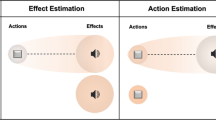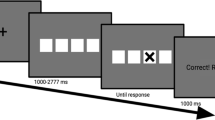Abstract
This paper experimentally studies the relationship between happiness, attention and time perception. The experimental results challenge the prevailing results in the economic and psychological literature. A Go/No-Go test reveals a clear negative correlation between happiness and attention: the subject who is happier is also more inattentive, probably because of his or her state of lightheartedness, a state of mind that seems to negatively affect performance. Furthermore, the fact that happier subjects evaluate the passage of time with different objective and subjective measures opens up paths of further research in assessing a new feature of happiness.
Similar content being viewed by others
References
Andershed H, Kerr M, Stattin H, Levander S (2002) Psychopathic traits in non-referred youths: a new assessment tool. In: Blaauw E, Sheridan L (eds) Psychopaths: current international perspectives. Elsevier, The Hague, pp 131–158
Aron AR, Poldrack RA (2006) Cortical and subcortical contributions to stop signal response inhibition: role of the subthalamic nucleus. J Neurosci 26:2424–2433
Bezdjian S, Baker LA, Lozano DI, Raine A (2009) Assessing inattention and impulsivity in children during the Go/NoGo task. Br Dev Psychol 27(2):365–383
Bishop BJ (2008) Trait anxiety and impoverished prefrontal control of attention. Neuroscience 12:92–98
Bschor T, Ising M, Bauer M, Lewitzka U, Skerstupeit M, Müller-Oerlinghausen B, Baethge C (2004) Time experience and time judgment in major depression, mania and healthy subjects. A controlled study of 93 subjects. Acta Psychiatr Scand 109:222–229
Buhusi CV, Meck WH (2005) What makes us tick? Functional and neural mechanisms of interval timing. Nat Rev Neurosci 6:755–765
Converse AK, Ahlers EO, Travese BG, Davidson RJ (2014) Tai chi training reduces self-report of inattention in healthy young adults. Front Hum Neurosci 27:8–13
Costa RT, McCrae RR (1984) Concurrent validation after 20 years: the implications of personality stability for its assessment. In: Butcher JN, Spielberger CD (eds) Advances in personality assessment. Erlbaum, Hillsdale, pp 31–54
Costa RT, McCrae RR (1988) Personality in adulthood. J Pers Soc Psychol 54:853–863
Costa RT, McCrae RR, Zonderman AB (1987) Environmental and dispositional influences on well-being longitudinal follow-up of an American national sample. Br J Psychol 78:299–306
Csíkszentmihályi M (1990) Flow: the psychology of optimal experience. Harper and Row, New York
Donner J, Csíkszentmihályi M (1992) Transforming stress into flow. Executive Excell 9:16–17
Dougherty DM, Bjork JM, Marsh DM, Moeller FG (2000) A comparison between adults with conduct disorder and normal controls on a continuous performance test: differences in impulsive response characteristics. Psychol Rec 50:203–219
Droit-Volet S, Meck WH (2007) How emotions colour our time perception. Trends Cogn Sci 11:504–513
Easterlin RA (1974) Does economic growth improve the human lot? In: David PA, Reder MW (eds) Nations and households in economic growth: essays in honor of Moses Abramovitz. New York Academic Press, New York, pp 89–125
Eysenck MW, Derakshan N, Santos R, Calvo MG (2007) Anxiety and cognitive performance: attentional control theory. Emotion 7:336–353
Freedman VA, Conrad FG, Cornman JC, Schwarz N, Stafford FP (2014) Does time fly when you are having fun? A day reconstruction method analysis. J Happiness Stud 15:639–655
Gibbon J, Church RM, Meck WH (1984) Scalar timing in memory. In: Gibbon J, Allan LG (eds) Timing and time perception. New York Academy of Sciences, New York, pp 52–77
Gibbon J, Malapani C, Dallen CL, Gallistel CR (1997) Toward a neurobiology of temporal cognition: advances and challenges. Curr Opin Neurobiol 7(2):170–184
Gil S, Droit-Volet S (2009) Time perception, depression and sadness. Behav Process 80:169–176
Hammond C (2012) Time warped: unlocking the mysteries of time perception. Canongate, Edinburgh
Hinton SC, Meck WH (1997) The “internal clocks” of circadian and interval timing. Endeavour 21:82–87
Kahneman D (1999) Objective happiness. In: Kahneman D, Diener E, Schwarz N (eds) Well-being: the foundations of hedonic psychology. Russell Sage Foundation, New York, pp 3–25
Keller J, Bless H (2008) Flow and regulatory compatibility: an experimental approach to the flow model of intrinsic motivation. Pers Soc Psychol Bull 34:196–209
Kitamura T, Kumar R (1982) Time passes slowly for patients with depressive state. Acta Psychiatr Scand 65(6):415–420
Mahlberg R, Kienast T, Bschor T, Adli M (2008) Evaluation of time memory in acutely depressed patients, manic patients, and healthy controls using a time reproduction task. Eur Psychiatry 23:430–443
Meck WH (1996) Neuropharmacology of timing and time perception. Cogn Brain Res 3:227–242
Moeller FG, Barratt ES, Dougherty DM, Schmitz JM, Swann AC (2001) Psychiatric aspects of impulsivity. Am J Psychiatry 158:1783–1793
Roy M, Peretz I, Rainville P (2008) Emotional valence contributes to music-induced analgesia. Pain 134(1/2):140–147
Rubia EA (2001) Mapping motor inhibition: conjunctive brain activations across difference versions of Go/No-Go and Stop tasks. NeuroImage 13:250–261
Scitovsky T [1976] (1992) The joyless economy: the psychology of human satisfaction. Oxford University Press, Oxford
Sen A (1992) Capability and wellbeing. In: Sen A, Nussbaum M (eds) The quality of life. Clarendon Press, Oxford, pp 30–53
Striker G (1990) Ataraxia: happiness as tranquillity. The Monist 73(1):97–110
Tellegen A, Lykken DT, Bouchard TJ Jr, Wilcox KJ, Segal NL, Rich S (1988) Personality similarity in twins reared apart and together. J Pers Soc Psychol 54:1031–1037
Thayer S, Schiff W (1975) Eye-contact, facial expression and the experience of time. J Soc Psychol 95(1):117–124
Veenhoven R (1994) Is happiness a trait? Tests of the theory that a better society does not make people any happier. Soc Indic Res 32:101–160
Author information
Authors and Affiliations
Corresponding author
Rights and permissions
About this article
Cite this article
Di Giovinazzo, V., Novarese, M. The meaning of happiness: attention and time perception. Mind Soc 15, 207–218 (2016). https://doi.org/10.1007/s11299-015-0180-1
Received:
Accepted:
Published:
Issue Date:
DOI: https://doi.org/10.1007/s11299-015-0180-1




